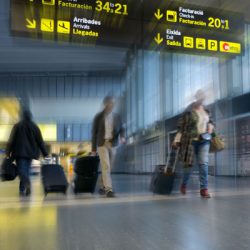Haneda Airport introduces autonomous drive system for PRMs
By introducing the new autonomous system, Haneda Airport will improve the experience for PRMs and help to limit the spread of COVID-19.
List view / Grid view


‘Seamless travel’ is a term frequently being used to describe the optimum passenger experience, meaning a traveller can complete the entire airport journey without experiencing delays, disruption or confusion.
Self-service technology, predictive analysis, artificial intelligence, real-time information and data-sharing are just some of the digital concepts airports around the world are deploying in an attempt to achieve a seamless passenger experience.
International Airport Review, within this core topic, endeavours to provide case studies on how airports from all corners of the world are working on improving their passengers’ experience. This covers both inside the terminal, and initiatives implemented outside of the terminal that focus on ensuring the passengers’ arrival to the airport is as easy as possible.
This is a key theme in the airport industry that must not be overlooked: As passenger expectations evolve, an airport’s response must do so too.
By introducing the new autonomous system, Haneda Airport will improve the experience for PRMs and help to limit the spread of COVID-19.
Despite the International Air Transport Association (IATA) warning that passenger demand will not fully recover until 2024, flight data consolidator OAG is reporting green shoots of recovery.
Answering some of the industry's questions regarding COVID-19, whilst offering examples of how to improve operational efficiency, this magazine issue is an imperative resource for aviation.
The modernisation of Belgrade Airport has continued in accordance with all COVID-19 health and safety prevention measures prescribed by relevant authorities.
New health protection measures have been introduced by AGS Airports at Aberdeen, Glasgow and Southampton airports as airlines begin to resume operations.
Airports and aviation organisations share COVID-19 experiences with Airport Regions Council (ARC), including innovative solutions that proved efficient.
Now part of EASA's COVID-19 programme, Brussels Airport has introduced a wide range of new health measures in order to keep passengers safe.
Marius Gelzinis, CEO of Lithuanian Airports, discusses the impact of COVID-19 on the operator’s airports, as well as what the future of aviation looks like, in the latest instalment of International Airport Review’s CEO series.
The first 10 companies to join EASA's COVID-19 programme include seven airports and airport operators from across Europe, as well as three airlines.
Green Furniture Concept has launched a social meeting point with space for distancing, while keeping the feeling of community.
In all areas – efficiency and effectiveness, revenue generation, safety and security – AI has tremendous potential to deliver positive change if used correctly, details Ian Law, Chief Information Officer of San Francisco International Airport.
The new Sydney Metro – Western Sydney Airport line will be open in time for the airport's first flight, scheduled for 2026.
As her last month as ACI World’s Director General begins, Angela Gittens spoke to Tara Nolan to reflect on her time spent within aviation.
According to the results of the quarterly ACI ASQ survey, Pulkovo Airport outranked 113 other European airports listed.
Don’t waste time and effort - maximise your airport sanitation procedures with passenger behaviour data.